Portálový jeřáb vs. portálový jeřáb: 6 klíčových výhod, které vám pomohou vybrat nejlepší možnost
Obsah
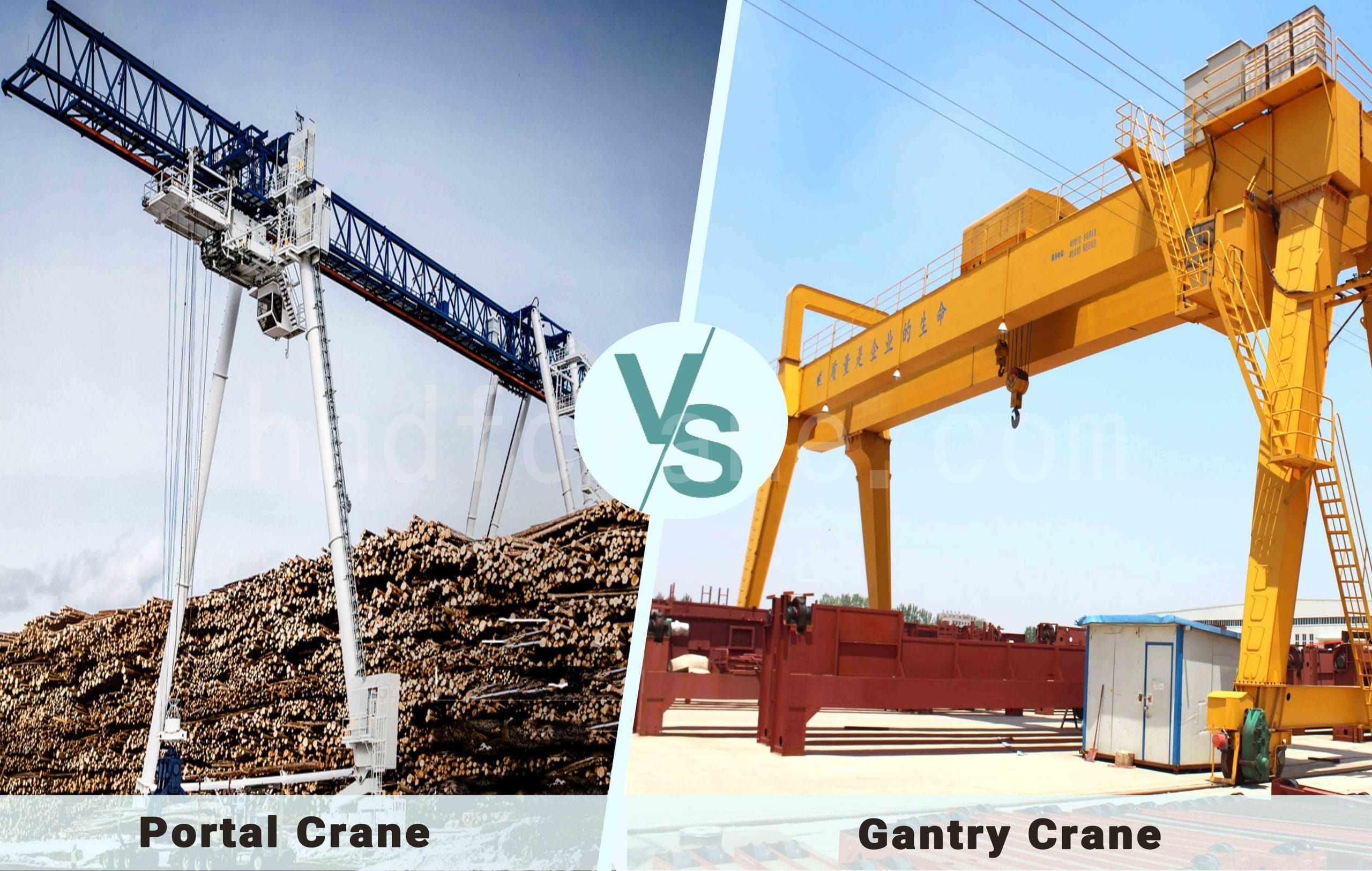
Při výběru zvedacího zařízení je důležité pochopit rozdíly mezi různými typy jeřábů. Portálové jeřáby a portálové jeřáby jsou dva běžné typy, každý s jedinečným designem a aplikací. Ale co přesně je odlišuje? Který z nich lépe vyhovuje vašim potřebám? V tomto článku prozkoumáme vlastnosti, výhody a nevýhody portálových jeřábů a portálových jeřábů, abychom vám pomohli vybrat tu nejlepší volbu.
1.Porovnání základních informací
Definice portálového jeřábu:
- Navrženo pro dlouhé trasy, lze jej otáčet o 360° na oběžné dráze.
- Často se používá při stohování dřeva na dvoře, stohování na dvoře.
- Portálový jeřáb se stará o vykládku a skladování dřeva, stejně jako o přikládání dřeva, vše v jednom celku. Může dokončit až 40 vyzvednutí za hodinu (pokud je cestovní vzdálenost minimální). Tímto způsobem lze v případě potřeby vyložit mnoho nákladních vozidel. Najednou můžete urvat náklaďák surových sázek.
Portálový jeřáb použitelný průmysl:
- Pro náročné aplikace a prostředí v lesních produktech, intermodálních, biomasových/pelletových, betonářských a mnoha dalších průmyslových odvětvích musí být portálové jeřáby odolné.
Výhoda portálového jeřábu:
- Bezpečné, inteligentní a efektivní
- Šetří se energie, zvyšuje se výkon, využívá se rekuperační brzdění a při každém pohybu dolů nebo zpomalování se výkon posílá zpět do sítě, místo aby byl rozptylován odporem. S větším množstvím energie, která se vrací do sítě, je potřeba vyrábět méně energie, což zvyšuje úspory nákladů.
- Kabina řidiče je ergonomická, a když se pracovníci cítí pohodlně, je pravděpodobnější, že se soustředí na daný úkol, což snižuje riziko nehod nebo zranění.
- Přijměte chytrou technologii.
- Zvětšení úložné plochy.
- Portálový jeřáb zabírá pouze 4% prostoru dvora
- Portálový jeřáb také umožňuje vertikální skladování až do 22,86 m, což výrazně zvyšuje kubickou skladovací kapacitu úložiště.
- Portálový jeřáb je vybaven bouřkovými brzdami a může pracovat za všech povětrnostních podmínek, dokonce i v oblastech se silným větrem.
- Portálový jeřáb se přizpůsobuje pohybu po dráze – umožňuje jeřábu i dráze zůstat v dobrém stavu na dlouhé vzdálenosti.
Definice portálového jeřábu:
- Rozpětí je obecně 35 m, vhodné pro všeobecné použití.
Oblast použití portálového jeřábu:
- Nákladiště, staveniště, železniční překladiště
- Loděnice a přístavy
- Továrna na paprsky
Výhoda portálového jeřábu:
- Vysoká míra využití, široké použití, silná přizpůsobivost, velká všestrannost, je nejčastěji používaným portálovým zvedacím zařízením, jmenovitá hmotnost od 5t do 500t.
- Portálový jeřáb zabírá 25% plochy dvora.
Portálový jeřáb


Portálový jeřáb


2.Porovnání klasifikace
Portálový jeřáb
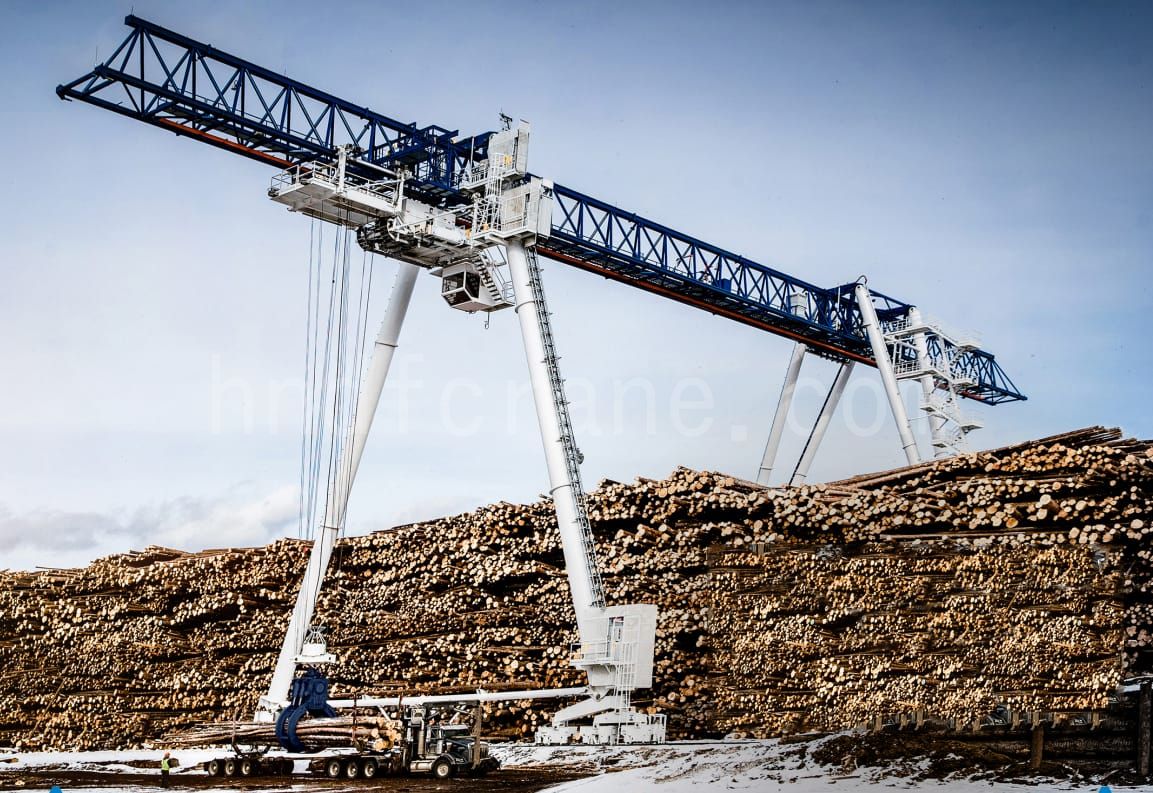
Portálové jeřáby s přímou dráhou
- Nejoblíbenější a optimální pro budoucí rozšiřování ranveje a rozšiřování úložného prostoru.
- Poskytuje optimální tok nákladní dopravy a maximální skladnost.
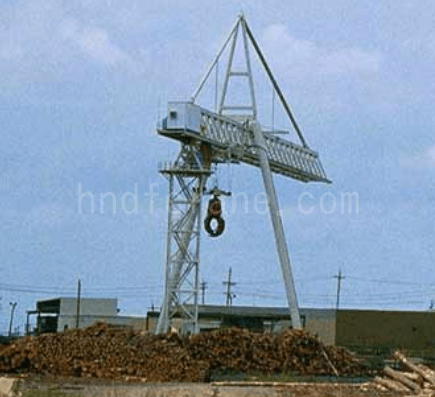
Otočné portálové jeřáby
- Často se hodí tam, kde se přímé kolejové jeřáby nevejdou.
- Poskytuje úložný prostor uvnitř i vně kolejnice.
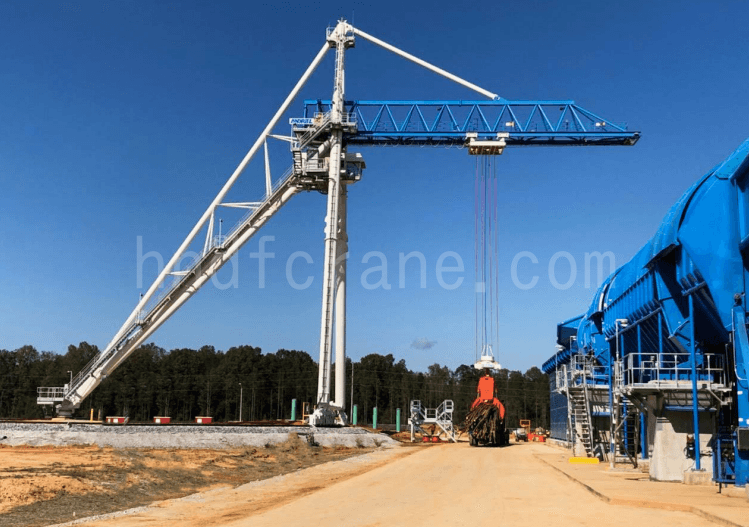
Jeřáby s výložníkem
- Jeřáb se otáčí kolem středové podpěry ložiska. Dvě velké přední nohy se pohybují po kruhové dráze, což umožňuje jeřábu skládat klády kolem sebe a skladovat je, dokud není nutné je vložit do zásobníku.
Portálový jeřáb
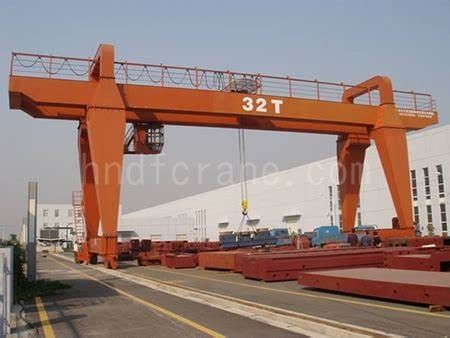
Dvojitá vnější konzolová zárubeň
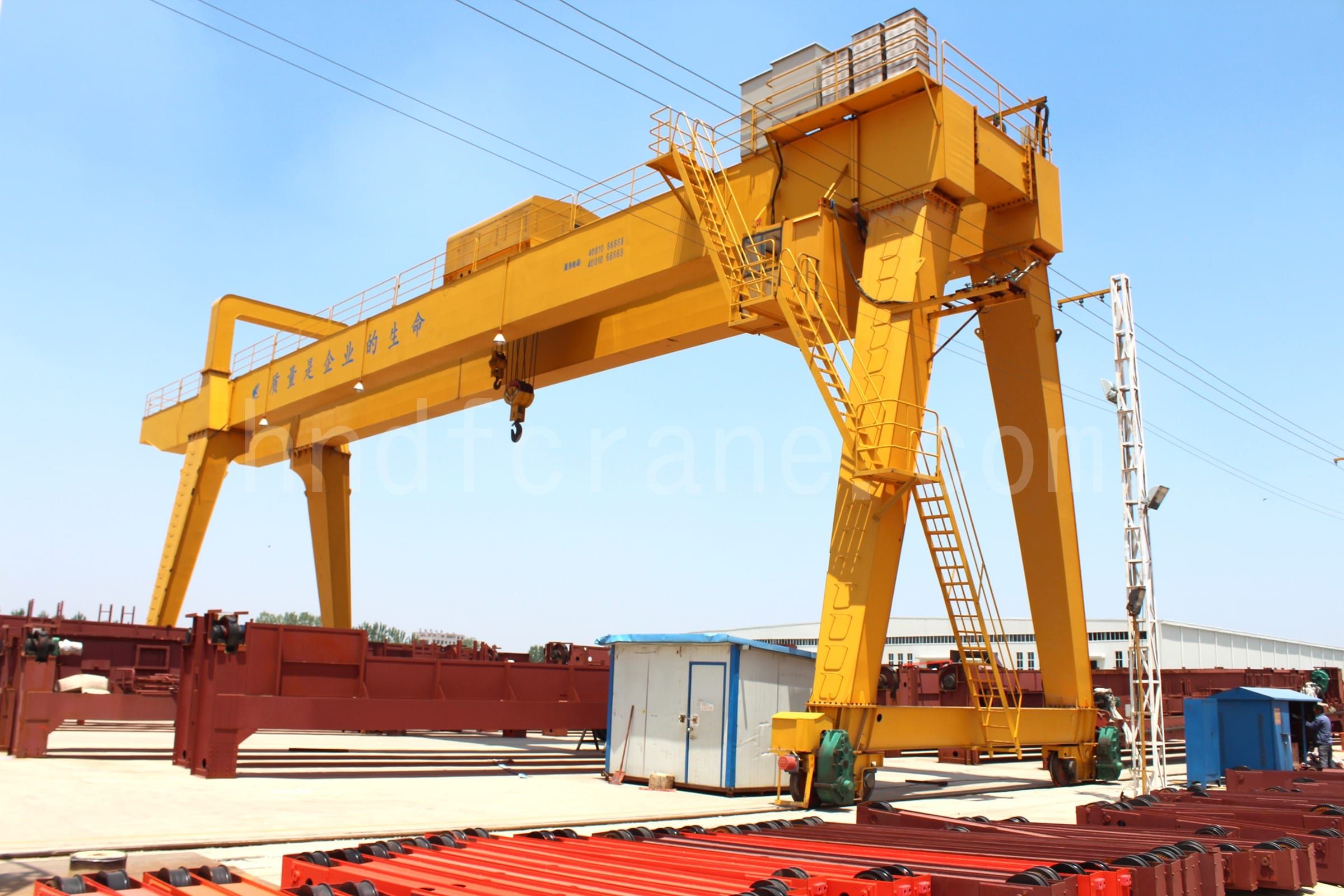
Jednostranná zárubeň s vnějším konzolovým rámem
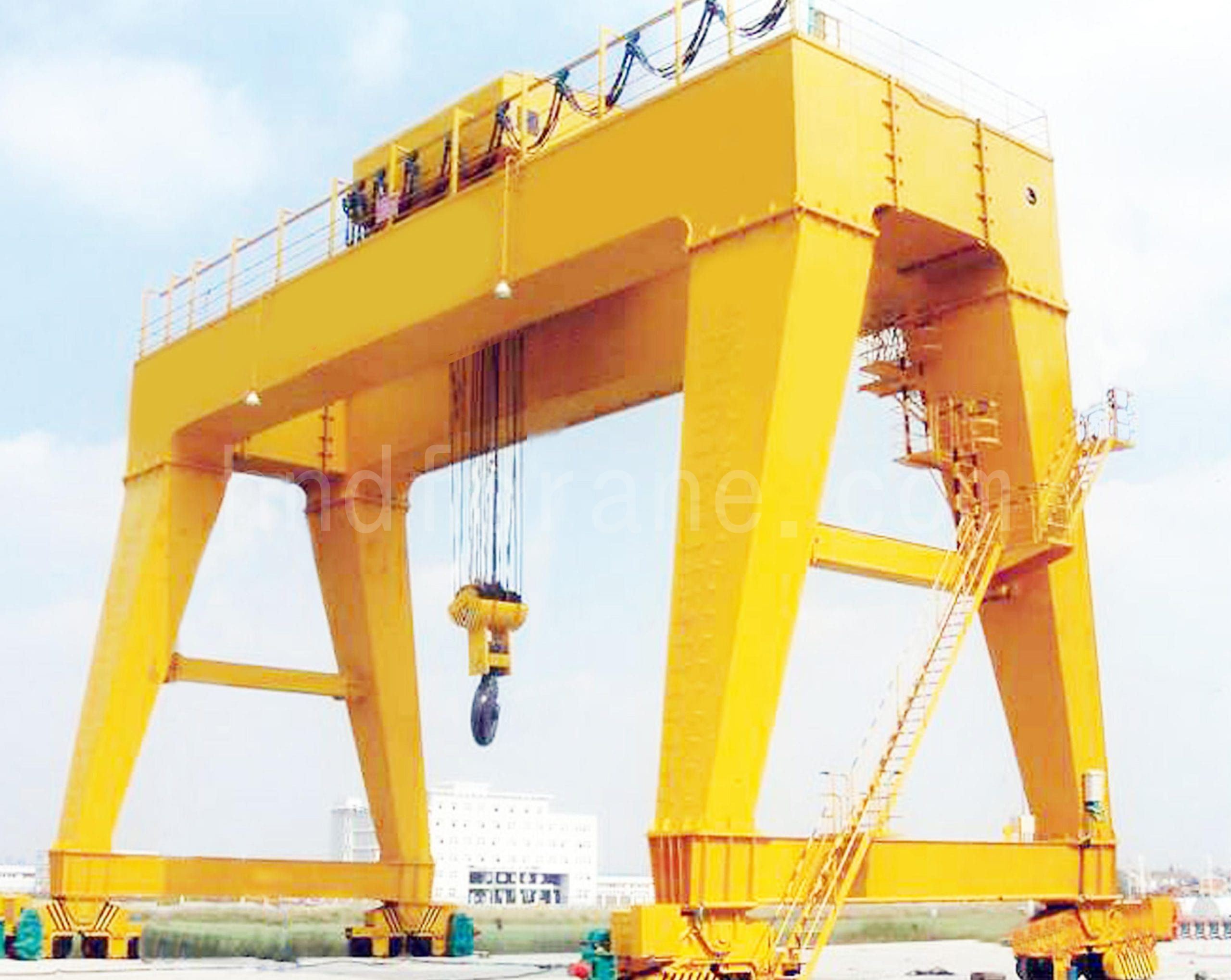
Bez vnějšího konzolového rámu
Tradiční portálové jeřáby je široce použitelný a existuje mnoho forem a klasifikací, v rámci této kategorie lze z výše uvedených tří typů vyrobit také příhradové portálové jeřáby, jeřáb Dafang může přizpůsobit produkty, které potřebujete, jeden k jednomu. Můžete nás kontaktovat, pokud budete něco potřebovat.
3. Porovnání nákladů
Počáteční investice do jeřábu Poral je obecně nižší než u tradičního portálového jeřábu, protože portálový jeřáb je lehčí a schopný provozu na tratích, které nevyžadují stejné požadavky na rovnoběžnost a přímost.
Portálový jeřáb vyžaduje pouze standardní pozemní koleje položené na železničních pražcích na štěrkovém loži nebo jednoduchém betonovém základu. Dokážou se přizpůsobit nestabilnímu terénu, omezují potřebu drahých povrchových prací a zároveň umožňují jeřábům pracovat na plný výkon všude tam, kde lze položit koleje. Tento typ instalace ušetří spoustu peněz ve srovnání s hlubokým a těžkým základem tradičního portálového jeřábu.
Úspora provozních nákladů, portálový jeřáb kombinuje vykládku, přepravu a stohování materiálů v jedné efektivní operaci. Kombinace těchto činností snižuje nároky na jednotku zařízení, údržbu a personál, což výrazně snižuje provozní náklady ve srovnání s loděnicemi využívajícími portálový jeřáb.
Jeřáb Poral je vybaven energeticky účinnými motory a ovládacími prvky navrženými pro dlouhodobý spolehlivý provoz bez větší údržby a souvisejících nákladů.
4.Rozdíl mezi konstrukcí skříňového nosníku a konstrukcí květinového stojanu (krovu).
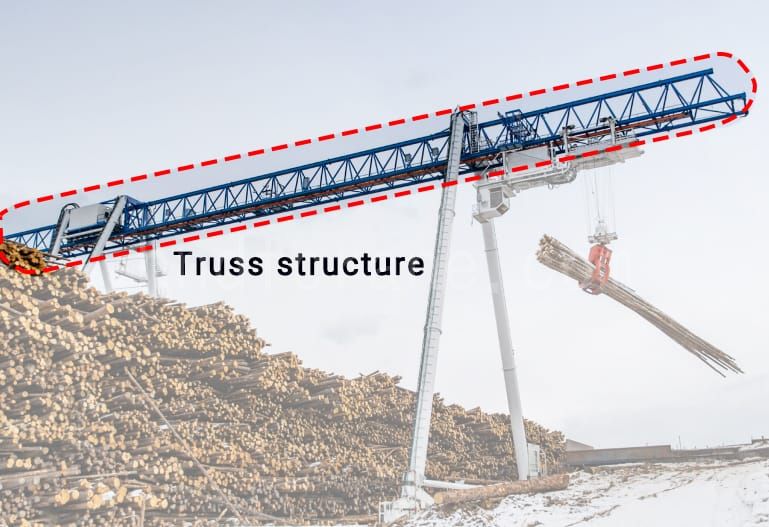
- Tato konstrukce mřížky je nákladově efektivní ve srovnání s skříňové nosníkové konstrukce. Otevřená konstrukce také umožňuje snadnou kontrolu kritických svarů po celou dobu životnosti jeřábu.
- Příhradový nosník je hlavní nosník s opačným materiálem (jako je profilová ocel, Úhlová ocel, ocel ve tvaru T), který může nastavit úhel a délku a je vhodnější pro manipulaci s nepravidelnými předměty.
- Tato konstrukce může snížit návětrnou plochu jeřábu, silná odolnost proti větru, vhodná pro použití na větrných otevřených místech.
- Otevřená konstrukce také umožňuje snadnou kontrolu kritických svarů po celou dobu životnosti jeřábu.
- Díky otevřené konstrukci příhradové hlavní nosníkové konstrukce je generální oprava a údržba relativně jednoduchá, zejména u některých příliš malých konstrukcí, které lze lépe sledovat a zmenšit slepou plochu v procesu údržby.
- Příhradová konstrukce hlavního nosníku má větší volnost konstrukce nohou, lepší přizpůsobivost a flexibilitu.
- Příhradová konstrukce hlavního nosníku se pohodlněji rozebírá. Díky odnímatelné konstrukci nohou.
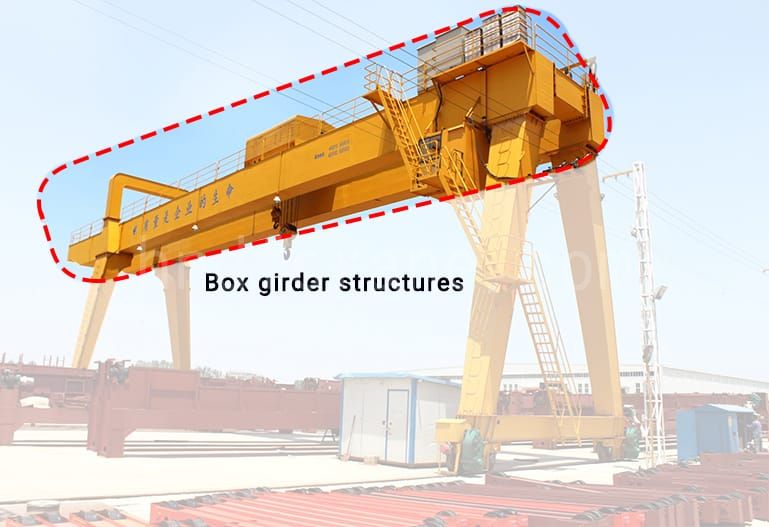
- Portálový jeřáb se skříňovou konstrukcí má slabou odolnost proti větru, vlastní zatížení a vyšší cenu než příhradový typ.
- Skříňový nosník portálového jeřábu je vyroben z ocelového plechu svařeného do skříňové konstrukce.
- Portálový jeřáb skříňové konstrukce je zcela uzavřen a nemůže přímo pozorovat a kontrolovat jeho vnitřní mechanickou konstrukci.
- Portálový jeřáb skříňového typu má dobrou strukturální stabilitu, která může lépe udržovat bezpečnost a spolehlivost provozu zařízení.
- Portálový jeřáb se skříňovou konstrukcí má delší životnost díky dobré odolnosti proti únavě.
- Portálový jeřáb skříňové konstrukce by měl mít určité hardwarové vybavení a podmínky na místě použití, než bude možné jej demontovat.
Reference: 大跨度门式起重机刚性支腿对结构刚度的影响分析
5. Rozdíl mezi pružnými nohami a sklopnými nohami
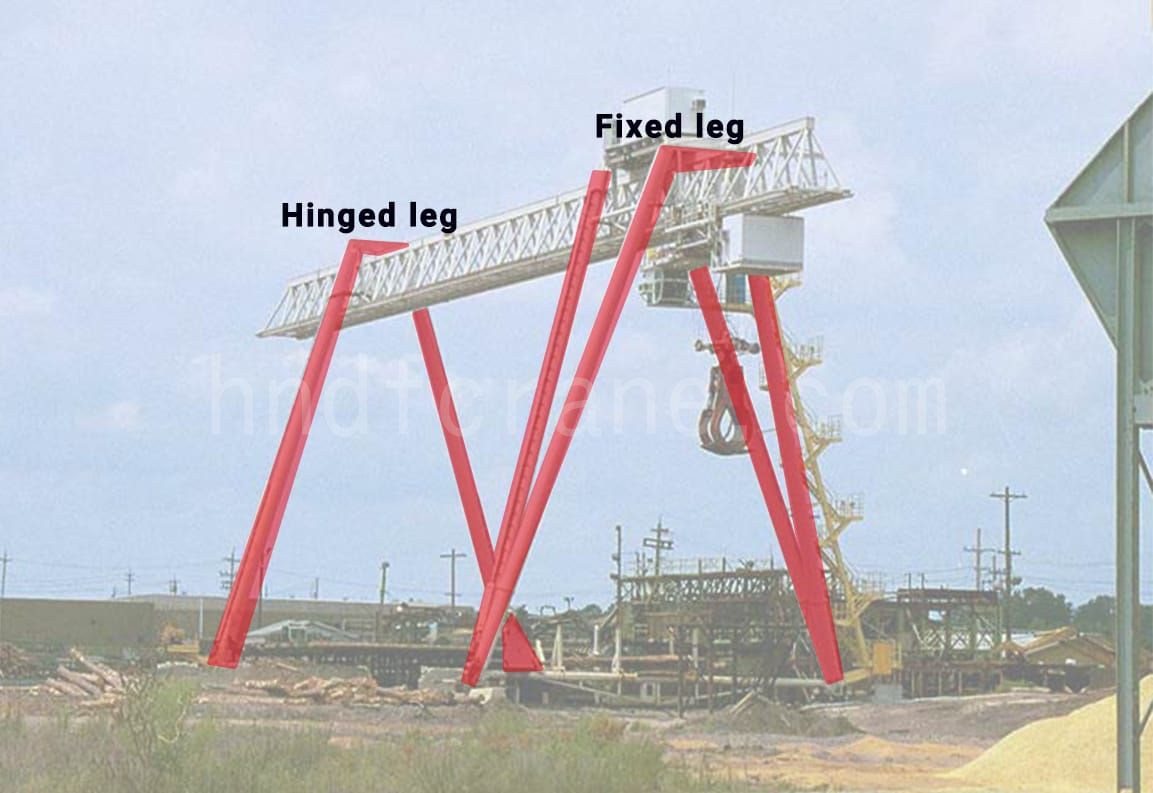
- Portálový jeřáb je navržen pro maximální flexibilitu, snižuje údržbu konstrukce a kolejí na minimum. Portálový jeřáb je navržen pro maximální flexibilitu, která snižuje údržbu konstrukce a kolejí na minimum.
- Pružné nohy mají určitý stupeň volnosti a při spojení s hlavním nosníkem jsou kloubové.
- Pružné nohy jsou svařeny dvěma ocelovými trubkami stejné tloušťky stěny a dno je spojeno se spodním nosníkem v trojúhelníkové konstrukci s dobrou stabilitou.
- Vzhledem k tomu, že flexibilní nohy lze posouvat po kruhové dráze jeřábu, je vhodný pro některá místa, kde je vyžadováno, aby jeřáb prováděl práci v zakřivení.
- Je více inkluzivní pro základ a může být aplikován na nerovný povrch.
- Ohebné nohy jsou také vhodné pro operace, které vyžadují, aby jeřáb najížděl nebo přejížděl jiné konstrukce.
- Slabá nosnost.
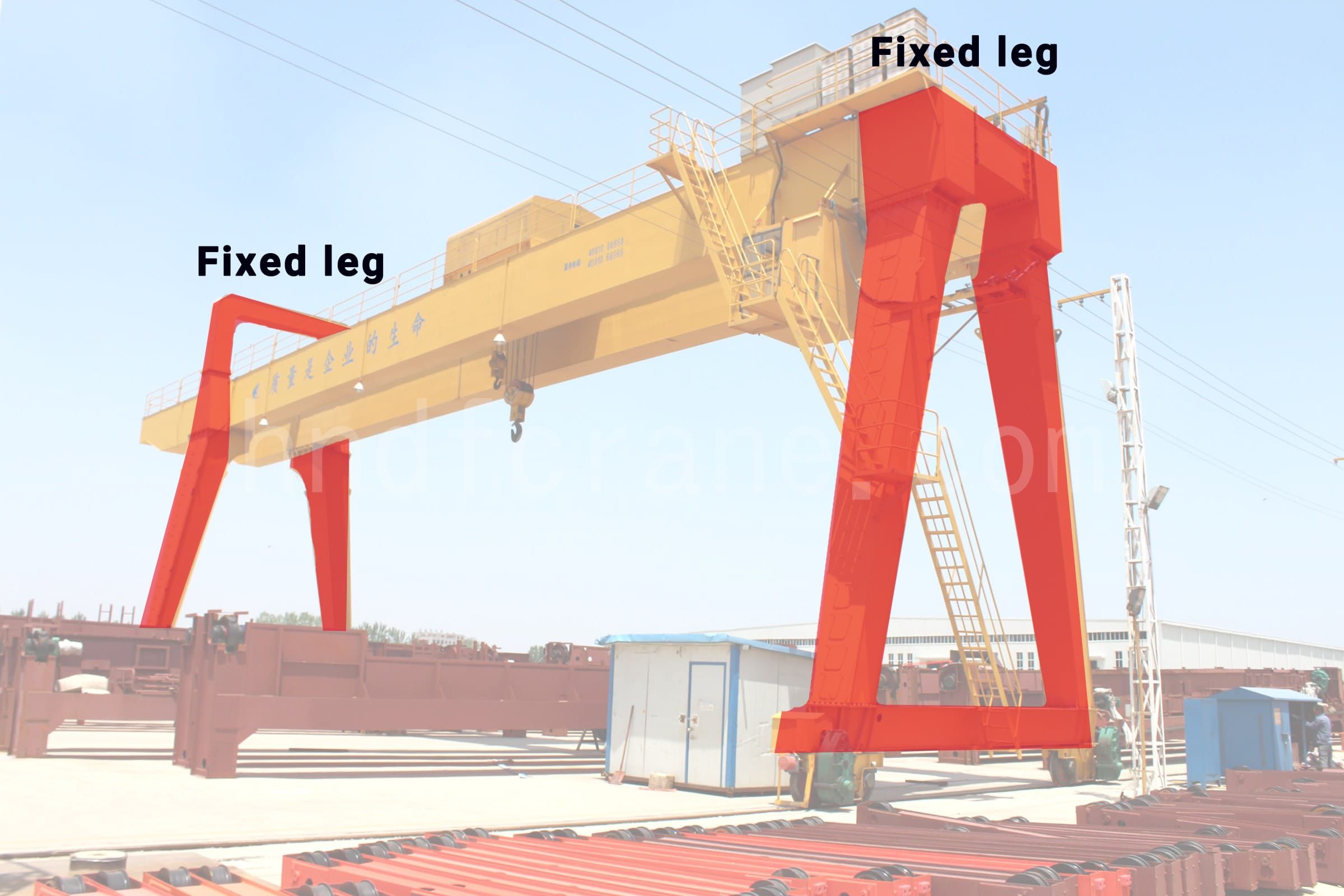
- Pevné nohy jsou při připojení k hlavnímu nosníku přišroubovány, takže stupeň volnosti je plně omezen
- Tuhá noha je také krabicové konstrukce a její velikost průřezu se shora dolů zmenšuje.
- Díky silné nosnosti a stabilitě tuhé nohy je vhodný pro některá místa, kde je vyžadováno, aby jeřáb prováděl operace s vysokým zatížením a vysokou přesností.
- Pevné nohy nesou velké množství jeřábového vybavení, jako jsou elektrické velíny, odpory atd. Aby se personálu usnadnil přístup do kabiny řidiče nebo na hlavní nosník, je mezi dvě pevné nohy instalován eskalátor.
- Pevné nohy jsou také vhodné pro širokou škálu provozů, jako je těžba a manipulace v povrchových dolech, velkých skladovacích dvorech atd.
- Vysoké náklady na údržbu a vysoké požadavky na základ
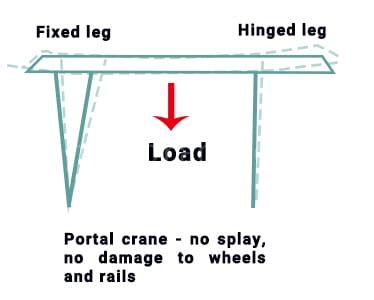
- Portálový jeřáb má pevnou a flexibilní konstrukci nohou. Tato tuhá a flexibilní konstrukce umožňuje nohám volně se otáčet vzhledem k hlavnímu nosníku, což může snížit jev koncentrace napětí způsobený operací průhybu portálového jeřábu nebo tepelnou roztažností hlavního nosníku
- Portálový jeřáb na obou stranách má obvykle podobu jedné tuhé nohy a jedné pružné nohy. Jedna noha portálového jeřábu je kloubově spojena s mostem, takže celý portál je staticky určitým systémem, který eliminuje boční tah vozu na kolej způsobený zvedacím břemenem. Přitom napjatost staticky určitého portálového systému je při šikmé jízdě vozu poměrně zřetelná.
- Tento typ konstrukce má však nízkou konstrukční tuhost, špatné dynamické vlastnosti, velké boční posunutí generované hlavním nosníkem při zvedání a nedostatečnou vertikální horizontální dynamickou tuhost.

- Plně naložený vozík portálového jeřábu je umístěn uprostřed hlavního nosníku. V důsledku nesynchronizace vozíku pod nohami na obou stranách bude rám portálu zkroucený a dojde k vážným nehodám s katastrofálními následky.
- Pevné konstrukce, jako jsou portálové jeřáby se skříňovými nosníky, jsou extrémně citlivé na boční zatížení způsobené vychýlením nohou, což vede k opotřebení okolků kol a případné výměně kolejí.
- Portálový jeřáb využívá konstrukci dvojité tuhé nohy s vysokou tuhostí a dobrými dynamickými vlastnostmi. Díky své staticky neurčité struktuře se však spodní část nohy při přenášení zvedacího břemene posune směrem ven. Pokud přesazení přesahuje mezeru mezi kolem a pásem (za normálních okolností: mezera mezi kolem a pásem nepřesahuje 15 mm, jeřáb nenastane nebezpečným problémům), pak bude nákladní automobil vyvíjet velký boční tah na kolej, síla je nepříznivá pro provoz vozíku a způsobí jev hlodání kolejnice. Zároveň jsou kladeny vyšší požadavky na upevnění kolejnice, zejména při velkém rozpětí se i v nezatíženém stavu projeví jev ohryzávání kolejnice.
6. Porovnání základny jeřábu

- Obrázek ukazuje průřezový diagram základové dráhy ve stylu „kravaty a zátěže“, která se používá k podpoře jeřábu. Základ je postaven z několika vrstev, z nichž každá slouží jinému účelu, aby byla zajištěna stabilita, odolnost a správné odvodnění. Zde je rozdělení vrstev zdola nahoru:
- Drain Stone: Toto je nejspodnější vrstva, sestávající z kamenů navržených tak, aby zajišťovaly správné odvodnění. Tato vrstva zajišťuje, že se pod základem nehromadí voda, která by jinak mohla vést k oslabení nebo erozi.
- Zhutněný subbalast: Nad vrstvou drenážního kamene je zhutněný subbalast. Tato vrstva je obvykle vyrobena z jemnějších materiálů a je zhutněna, aby poskytla stabilní základ pro horní vrstvy. Pomáhá rovnoměrněji rozložit zatížení z výše uvedených vrstev a přidává další drenážní schopnost.
- Geomřížka: Nad zhutněným podštěrkem je umístěna geomříž. Geomříže jsou geosyntetické materiály používané k vyztužení půdy, poskytující základu dodatečnou stabilitu a pevnost. Zabraňují pohybu podloží a zvyšují celkovou nosnost základu.
- Horní předřadník: Tato vrstva se skládá z větších kamenů nebo štěrku, které poskytují pevný základ pro betonové pražce. Zátěž je rozhodující pro rozložení zatížení z kolejnic a pražců a pro udržení vyrovnání koleje tím, že odolává bočním, podélným a vertikálním silám.
- Betonová kravata: Betonové pražce (nebo pražce) jsou umístěny na horní vrstvě štěrku. Tyto spojky jsou kritickými součástmi, které drží kolejnice na místě, udržují rozchod a vyrovnání kolejí.
- Železnice: Nakonec se kolejnice položí na betonové pražce. Kolejnice jsou koleje, po kterých se jeřáby pohybují. Jsou připevněny k betonovým vazbám pomocí spon nebo jiných spojovacích prvků, aby je bezpečně udržely na místě.
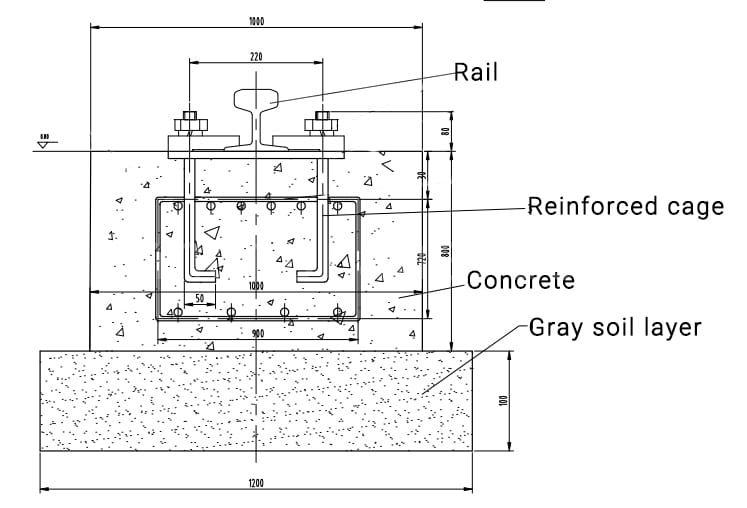
- Poskytnutý obrázek ukazuje technický výkres návrhu základů pro železniční trať. Detailně popisuje průřez základem, zvýrazňuje vrstvy a komponenty použité při jeho konstrukci. Zde je rozpis prvků zobrazených na výkresu:
- Železnice:Toto je nejvyšší součást nadace. Kolejnice je kovová dráha, po které se pohybují vlaky nebo jeřáby. Obvykle je vyroben z vysokopevnostní oceli a je připevněn k betonovému základu pomocí šroubů a spojovacích prvků. Zobrazená kolejnice je namontována přímo na betonový povrch.
- Vyztužená klec:Pod příčkou, zapuštěnou do betonu, je vyztužená ocelová klec. Tato klec se skládá z ocelové výztuže uspořádané do mřížkového vzoru, který poskytuje pevnost v tahu a zvyšuje celkovou strukturální integritu betonu. Vyztužená klec zabraňuje praskání a rovnoměrněji rozkládá zatížení v betonu.
- Konkrétní:Betonová vrstva tvoří hlavní těleso základu. Je to pevný, vyztužený blok, který podpírá kolejnici a absorbuje zatížení přenášené z kolejnice. Beton se nalije přes vyztuženou ocelovou klec a je navržen tak, aby nesl značné tlakové síly. Na výkrese je uvedena tloušťka betonového základu 900 mm, která poskytuje značnou stabilitu a podporu.
- Šedá vrstva půdy:Šedá vrstva zeminy je základem, na kterém spočívá celý základ. Tato vrstva se pravděpodobně skládá ze zhutněné zeminy nebo připraveného podloží, které poskytuje stabilní základ pro betonový základ. Výkres ukazuje, že tato vrstva má tloušťku 100 mm, což naznačuje, že je dobře zhutněná a slouží jako základ pro rozložení zatížení od betonového základu.
Portálový jeřáb vyžaduje pouze standardní pozemní koleje položené na železničních pražcích na štěrkovém loži nebo jednoduchém betonovém základu. Dokážou se přizpůsobit nestabilnímu terénu, omezují potřebu drahých povrchových prací a zároveň umožňují jeřábům pracovat na plný výkon všude tam, kde lze položit koleje. Tento typ instalace nabízí značné úspory ve srovnání s ocelovou konstrukcí portálového jeřábu nebo hlubokým a těžkým základem tradičního portálového jeřábu.
V souhrnu
Když vezmete v úvahu úsporu velikosti dvorku, menší pracovní sílu, rychlejší otáčení kamionů, méně kusů vybavení, sníženou údržbu, eliminaci spotřeby topného oleje a kontaminace půdy, portálový jeřáb je SMART cestou.
Stručně řečeno, díky důkladnému pochopení rozdílů mezi portálovým jeřábem a portálovým jeřábem v pěti aspektech: klasifikace, cena, typ krabice a vazník, tuhá noha a flexibilní noha a základ, můžeme lépe vyhodnotit jejich výhody v různých scénářích použití. Portálový jeřáb se svou vysokou flexibilitou a přizpůsobivostí je vhodný pro použití v prostředích, kde je omezený prostor nebo je vyžadována různorodá manipulace, zatímco portálový jeřáb je se svou vynikající nosností a všestranností ideální pro úkoly těžkého zvedání. Při konečném rozhodování si můžete vybrat zvedací zařízení, které je pro vás nejlepší na základě vašich konkrétních provozních potřeb, rozpočtu a podmínek na místě.
Ať už hledáte přesné ovládání a všestrannost nebo stabilitu a efektivitu nákladů, tým odborníků společnosti Dafang crane vám může poskytnout personalizované rady a řešení, abyste zajistili maximální návratnost vaší investice. Kontaktujte nás a dovolte nám, abychom vám pomohli najít perfektní jeřábové řešení pro zlepšení vaší provozní efektivity!
Pošlete svůj dotaz
- E-mailem: sales@hndfcrane.com
- WhatsApp: +86-191 3738 6654
- Tel: +86-373-581 8299
- Fax: +86-373-215 7000
- Přidat: Changnao Industrial District, Xinxiang City, provincie Henan, Čína








































































